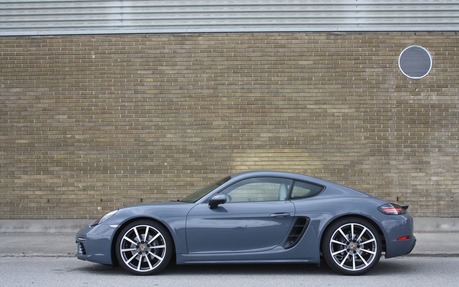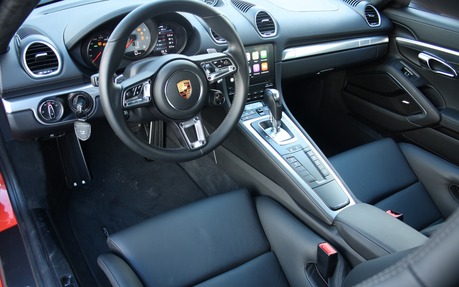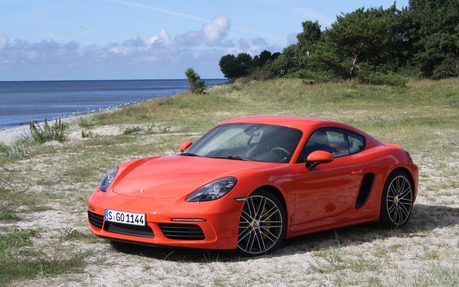2017 Porsche 718 Cayman: The Sound of Speed
MALMÖ, Sweden – Porsche’s little mid-engined coupe gets a new name, new engines and—arguably—a new personality. It’s essentially the same car as the current-generation Cayman sold from 2014 onwards, but it’s been thoroughly modified to continue its battle against, among others, the Audi TTS, the Jaguar F-TYPE and the Alfa Romeo 4C.
By now, you might have read that the Porsche Boxster became the 718 Boxster, and now it’s the Cayman’s turn to adopt the 718 moniker. The designation is simply a throwback to an open-cockpit race car the company had produced from 1957 to 1962, but it also ties the Boxster and Cayman together as one model line instead of two separate ones. Like the 911 Coupe and Cabriolet.
As with the 718 Boxster we drove recently, the big change here is the reappearance of a four-cylinder engine in a Porsche.
Less cylinders, more power
For the sake of reduced emissions, Porsche has brought back four-piston power to their product lineup, and it’s the 718 models that get it first. The last four-cylinder Porsche was the 968, sold from 1992 to 1995 as the successor or the popular 924 and 944 models of the Eighties. However, thanks to turbocharging and modern technology, these new engines produce a lot more power.
And yes, they are even more powerful than the 2.7L and 3.4L flat-sixes that used to hide deep below the Boxster and Cayman’s bodywork. Lowering the cars’ output would’ve been unthinkable, even though the smaller-displacement engines would be, uh, greener.
The 2017 Porsche 718 Cayman is once again offered in two variants, at least until the company spits out a slew of special-edition versions, which is usually the case. The base trim gets a turbocharged 2.0-litre flat-four that develops 300 horsepower as well as 280 lb.-ft. of torque that peaks from 1950 to 4500 rpm. Compared to the old 2.7-litre six, the new Cayman’s engine benefits from 25 extra ponies and a whopping 67 lb.-ft. more twist, allowing the car reach 100 km/h in as little as 4.7 seconds.

The 718 Cayman S relies on a 2.5-litre four that steals some trick components from the 911 Turbo’s engine, such as variable turbine geometry. It produces 350 horsepower as well as 309 lb.-ft. of torque between 1900 and 4500 rpm, up by 25 hp and 36 lb.-ft. compared to the 2016 car. According to Porsche, the Cayman S can blast from 0 to 100 km/h in 4.2 seconds with the help of the launch control system.
Once again, a six-speed manual is standard in both versions of the 718 Cayman. With short throws and a very mechanical feel of the shifter, it provides the sensation of being connected to the car’s powertrain during spirited driving. However, the throttle blipping feature that comes alive in Sport and Sport Plus modes may not be to everyone’s liking, and cannot be deactivated. No one should criticize us, or buyers, for preferring the PDK seven-speed automated transmission, which shifts through gears with the quickness of an Uzi and provides better fuel economy.
New this year is a wheel-mounted rotary dial for selecting between Normal, Sport, Sport Plus and Individual drive modes. Cars equipped with the PDK also benefit from a Sport Response button; when pressed, the turbo quickly spools up and the gearbox downshifts to the lowest possible gear, and full power is activated for a 20-second burst. It’s handy for passing slower-moving vehicles on the open road, a little like selecting the Sport Plus mode, but temporarily.
What about that sound?
From a dynamic standpoint, the Cayman always was a brilliant car. Yet somehow, the brand’s engineers cranked its handling characteristics up a notch with stiffer spring and stabilizer bars, revised shock tuning, sharper steering, bigger brakes and increased concerning stability with the adoption of rear tires that are a half-inch wider.
Porsche didn’t stop there, of course, as each car can be upgraded with the Sport Chrono Package, Porsche Torque Vectoring, Porsche Active Suspension Management and a PASM sport suspension. Every one of these options incrementally makes the 718 nimbler, quicker, meaner.
And mean can be the word used to best describe the new engines’ soundtrack. Both flat-fours emit a thumping groan at idle, and yell savagely as the driver nails the throttle against the firewall. They fart at every upshift and we can also hear them burble and spit as we lift our foot off the gas pedal.
At the Sturup Raceway in Malmö, Porsche gave us the opportunity to drive both versions of the 718 Cayman on the track. As expected, the excellent weight balance and low centre of gravity make the cars extremely agile, always feeling in control. The mechanical enhancements don’t drastically change the car’s handling, although the additional torque did allow us to blast out of corners much faster than we remember in the previous Cayman. The base car actually felt more sure-footed than the S around the track, likely because we were picking up more speed in the S and had to slow down more before hitting the track’s numerous curves and hairpins. An excellent circuit, by the way.
So, does the car sound better than before? Not really, but that’s my personal opinion. The old flat-sixes had a coarse, Porsche-characteristic roar that was pretty melodious. The new four-cylinders’ angry tune is still much enjoyable, but it’s not the same. As Porsche’s staff says, “it’s different.”
First-time Porsche buyers won’t mind, but purists might. Come to think of it, the 718s no longer sound like a 911, which isn’t necessarily a bad thing, because it helps provide these smaller models with their own distinct character. During our stay, we heard many of our colleagues ask Porsche reps if the 718 Boxster and Cayman will steal sales away from the 911; our answer to that is “more than ever, highly unlikely.”

And let’s not forget that the H6 engines were pretty efficient, and in real-world driving, the new four-cylinder mills might consume more fuel. In fact, looking at the manufacturer’s ratings for Canada, the base version boasts slightly better numbers in city driving, but worse numbers on the highway. In the case of the S, fuel consumption has risen by a few tenths of a litre both on the open road and around town. Oh well.
The new look
Cosmetic changes don’t seem that exhaustive at first glance, but the 2017 Porsche 718 Cayman is almost all-new on the outside. The rear trunklid, the roof and the windscreen are the only components salvaged from the old Cayman, the rest of the body has been redesigned. Noteworthy changes include a new front bumper with slim daytime running lights and turn signals, optional LED headlights instead of the standard xenon projectors and clear-lens taillights separated by a black plastic strip. The overall appearance is fresher, and still drop-dead gorgeous.
Inside, the Porsche Communication Management system is now standard, while the optional Porsche Connect module allows connecting smartphones and integrating Apple CarPlay. The Porsche Connect App also permits transferring a selected navigation destination from our phone to the car’s system. The PCM touchscreen is much-improved over the previous-generation setup, more reactive to finger input and with a much clearer information display.
As for price, well there’s good news and bad news. The good part is that the Cayman now costs less than the Boxster, which used to be the other way around. The bad part is that prices have gone up in both cases. The 718 Cayman now starts at $61,500 before freight and delivery charges, up by $1,600 compared to the 2016 car, while the 718 Cayman S costs $2,500 more than last year, starting at $75,600.
In its transformation from Cayman to 718, this coupe has nonetheless improved in many ways. Our choice would be the base 718 Cayman with the PDK gearbox and the Sport Chrono Package, which we think is the best all-around version of the line-up. The 718 Cayman will arrive in Canada at the end of 2016.
| Test drive report | |
| Test model | 2017 Porsche 718 Boxster |
|---|---|
| Trim level | Cayman |
| Price range | $61,500 – $75,600 |
| Price as tested | N/A |
| Warranty (basic) | N/A |
| Warranty (powertrain) | N/A |
| Fuel economy (city/highway/observed) | N/A |
| Options | N/A |
| Competitive models | N/A |
| Strong points |
|
| Weak points |
|
| Editor's rating | |
| Fuel economy | Still efficient, but the old flat-six engines could do as well in real-world driving |
| Comfort | Amazingly composed on open road, unless you choose the PASM and PASM sport suspensions |
| Performance | Gobs of torque at low rpm improve performance; especially in the base 718 Cayman |
| Infotainment | The new capacitive, multi-gesture touchscreen is a huge improvement |
| Driving | As before, the 718 Cayman is a thrilling car to drive fast |
| Overall | Improved performance for the 718 Cayman over the previous Cayman, and a slightly different personality. |
